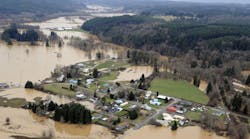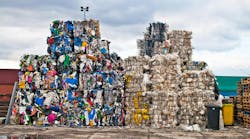Hawaii Explores Stormwater Reclamation
The state of Hawaii has joined federal water experts in a $400,000 study to see how difficult it would be to use storm water runoff to replenish drinking water aquifers.
The Hawaii Department of Land and Natural Resources and the U.S. Department of the Interior's Bureau of Reclamation, USBR, are studying the same reclamation technology in use nationwide to see how it could be applied in the Hawaiian Islands. Several successful storm water reuse projects have been constructed on the U.S. mainland and in other countries, but this is the first effort to identify a potential project in Hawaii.
Congress is providing the funds for the Bureau of Reclamation to work with the state of Hawaii to assist the Commission in researching ways of creating additional water supply through reclaimed storm water.
To help augment the state's potable water resources, Reclamation and the Commission are identifying and evaluating ways of intercepting storm water runoff - which often degrades the water quality of streams and near-shore waters or causes downstream flooding - so that it can be reclaimed for local beneficial uses.
Developing new approaches to using this runoff can help conserve more of Hawaii's fresh water for use in meeting future demands for this limited resource.
A study completed by the Bureau of Reclamation in 2005 identified potential opportunities for storm water reclamation and reuse. The agency has now awarded the engineering firm Brown and Caldwell a contract worth nearly $400,000 to further this research by identifying challenges to reclaiming storm water for future use, determining the viability of recharging the caprock aquifer with runoff and treated wastewater, and investigating creative methods for storm water capture, storage and use that are suitable for implementation in Hawaii.
"New uses and innovative applications of Hawaii's storm water flows can extend the state's fresh water supply," said John Johnson, USBR's project manager. "We are pleased to be participating in these cooperative efforts with the Commission on Water Resource Management to help meet the state's future water demands."
Given Hawaii's limited water resources and high population growth projections, storm water reclamation and reuse are being appraised as a method to augment the state's water resources.
Increased demand for water in a state with finite underground aquifers is at the core of the project, Neil Fujii, drought coordinator for the state Commission on Water Resource Management, told the Honolulu Advertiser.
"Over 99% of our drinking water is ground water," he said. "Any way we can reduce the withdrawals from our aquifers protects our resources."
Fujii said storm water that could be redirected to grassy areas and from there into aquifers could amount to billions of gallons.
"Usually what they do now is channel the water off the parking lot and into a storm drain and then into the ocean," Fujii said. "They have been doing that for years, but what people are doing now is looking at ways to actually keep this water on site. Maybe put in some infiltration basins."
Over the next 21 months, the Honolulu office of Brown and Caldwell will determine if purifying this potentially toxic runoff is too costly.
The study will recommend which reclamation methods would work best in Hawaii and explore how they can be used on Oahu's arid Ewa Plains, where homes are being built rapidly to alleviate the most populous island's housing shortage.
Unfiltered storm water can be contaminated with hazardous liquids, and as it runs off to the ocean, it could potentially contaminate coastal ecosystems.
Source: ENS


